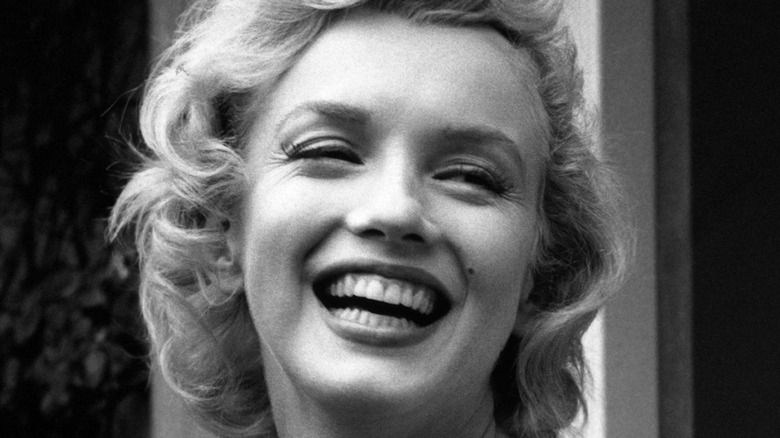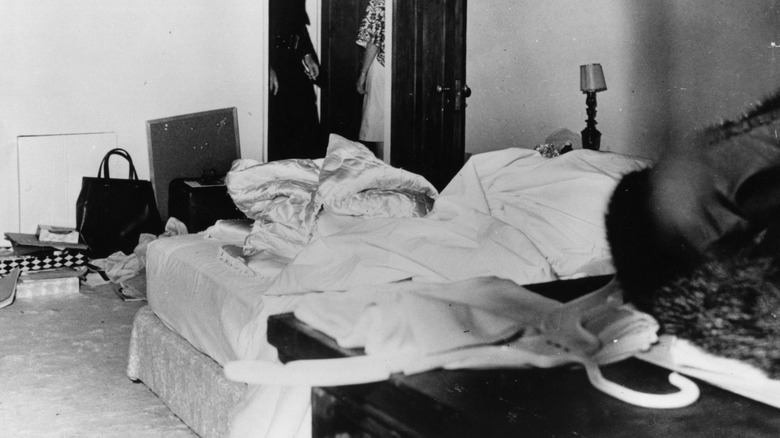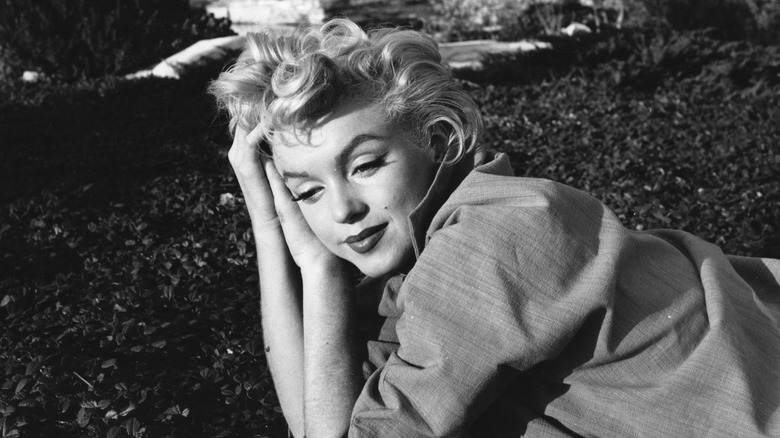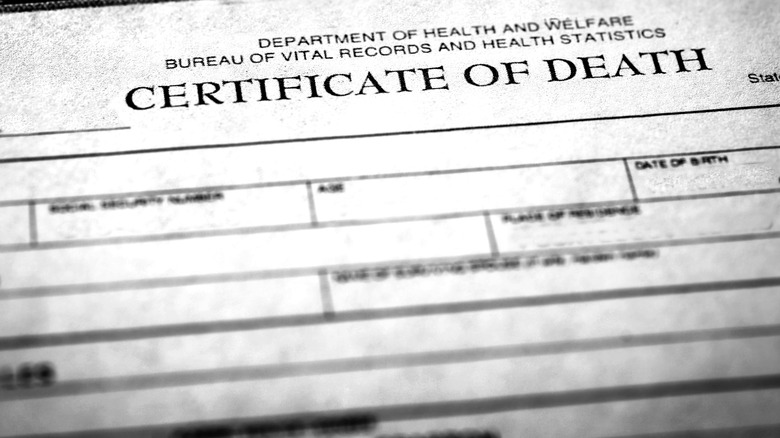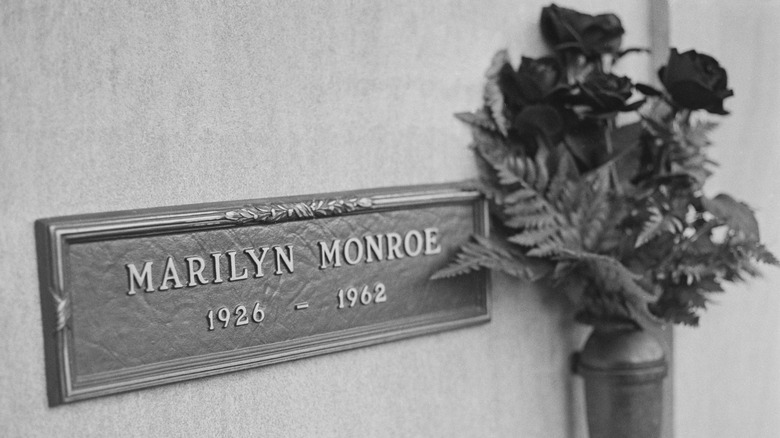Disturbing Details Discovered In Marilyn Monroe's Autopsy Report
On August 5, 1962, Hollywood icon Marilyn Monroe was found dead in her Los Angeles home at just 36 years old. On the day of her death, Eunice Murray, Monroe's housekeeper, noticed that the actress's bedroom light was on at 3 a.m. and knocked on her door to check on her. After getting no response from inside the bedroom and finding the door locked, Murray placed a call to Monroe's doctors, Dr. Hyman Engelberg and psychiatrist Dr. Ralph Greenson. Greenson broke through a window to reach Monroe and found the actress dead on her bed (via ATI).
Monroe was found naked on her bed with her right hand holding onto a telephone. She was officially pronounced dead shortly thereafter and authorities were called to the scene. On her bedside table were all sorts of pills, including sedatives and anti-depressants, per History. Just days before her death, those close to Monroe, including her manager, noticed the actress's moody behavior. Monroe's death shocked many and sparked conspiracy theories involving a murder plot and affairs.
What was found during Marilyn Monroe's autopsy?
Marilyn Monroe's official cause of death was listed as "acute barbiturate poisoning due to ingestion of overdose." Monroe's body was brought to the Los Angeles County Coroner's Mortuary where Deputy Medical Examiner T. Noguchi performed the autopsy. Based on his findings, the actress overdosed on sedatives, and although he didn't confirm that it was suicide, he said that it was probable, per eInvestigator.
Based on the toxicology report, Monroe had a lethal dose of Nembutal in her system. According to RxList, Nembutal is a barbiturate — which is in the sedative class — that is used for treating short-term insomnia. It was believed that Monroe had been in a depressed state before her death and consumed copious amounts of alcohol. On August 4, her psychiatrist asked Eunice Murray to keep a close watch on Monroe. Murray last saw Monroe alive at approximately 8 p.m. that night.
The autopsy report also included a statement from the psychiatric investigative team that was brought in to examine Monroe's death: "Miss Monroe suffered from psychiatric disturbance for a long time. She experienced severe fears and frequent depressions. Mood changes were abrupt and unpredictable," the report partially stated (via Autopsy Files).
If you or anyone you know is having suicidal thoughts, please call the National Suicide Prevention Lifeline at 1-800-273-TALK (8255).
Signs of suicide
Marilyn Monroe's autopsy report points to a probable suicide based on some of the clues discovered in and around her body; the findings of the psychiatric investigative team also support this theory. Aside from Monroe's reported depression and anxiety shortly before her death, the team also discovered that the actress "often expressed wishes to give up, to withdraw, and even to die" (per Autopsy Files). The report also states that Monroe previously attempted suicide by ingesting sedatives. But in that instance, she called for help and was saved just in time.
Another sign that points to suicide is the large number of sedatives found in her system that were said to have been taken in a short period of time. Despite being refilled the day before her death, her prescription bottle of Nembutal was found completely empty. Another unusual detail was Monroe's door, which was locked. Although these details were included in the autopsy report, the coroner can't conclusively prove that the actress took her own life, hence the description "probable suicide."
An account of her autopsy
John Miner was a district attorney in Los Angeles who was one of the investigators in Marilyn Monroe's death. In 2005, the Los Angeles Times published Miner's account of the star's autopsy based on his experience. He was allowed to witness the autopsy, as he was the head of the Medical-Legal Section, which was the unit responsible for dealing with investigations that involved complicated medical issues. There was no visible cause of death upon first inspection, such as needle marks or trauma. The blood test, however, pointed to what caused Monroe's death.
As previously mentioned, Monroe had an excessive amount of the drug Nembutal in her system. Furthermore, chloral hydrate, which is a sedative used to treat insomnia, was also found in her system but the dose was not fatal. Miner stated that the next step for the doctor who conducted the autopsy, Dr. Thomas Noguchi, was to determine how the large dose of Nembutal got into her system. However, it was a challenge, as per Miner's account, Monroe's organ samples, stomach content, and other specimens mysteriously disappeared. The medical examiner examined Monroe's liver and found that it contained 13% Nembutal, which is a significant amount.
John Miner's theory based on the autopsy
Based on the results of the autopsy, John Miner formed his own theory about how Marilyn Monroe died. No needle marks were found anywhere on her body, which eliminated the possibility of Nembutal being injected into her system. As noted by ATI, Miner also pointed out that Monroe couldn't have orally taken the drugs herself. When taken orally, the yellow capsules leave yellow stains in the stomach and parts of the small intestine, according to Miner, but there were no yellow stains in her stomach.
With these scenarios eliminated, Miner formed his own conclusion based on the facts he knew. As noted by his account reported by the Los Angeles Times, he believed that Monroe was given just enough chloral hydrate to make her unconscious. Someone then dissolved about 30 Nembutal capsules in water, which was given to Monroe via an enema bag. The drugs were absorbed by the large intestine, and that was how she died from an overdose. Based on his theory, Miner said that someone else killed Monroe. However, it is important to note that the statements were Miner's personal opinion, and Dr. Noguchi refuted his claim about the yellow dye. In addition, Miner was also accused of allegedly inventing information pertaining to the Marilyn Monroe case for monetary gain.
Conspiracy theories on Marilyn Monroe's death
Despite reports of depression, some of Marilyn Monroe's friends said that she was in high spirits and talked about traveling in the months before her death. There were even reports of the star rekindling her relationship with ex-husband Joe DiMaggio before she died. Indeed, DiMaggio believes that Monroe was murdered. As reported by People, he said in an interview: "I always knew who killed her, but I didn't want to start a revolution in this country. She told me someone would do her in, but I kept quiet."
One of the most popular conspiracy theories involves brothers John F. Kennedy and Robert F. Kennedy, who Monroe allegedly had affairs with, per Newsweek. Many believe that Monroe was killed in order to keep the affairs out of the public eye. Despite all the rumors, the official report states that no evidence of foul play was found (via ATI).
Monroe is buried at the Westwood Village Memorial Cemetery in Los Angeles, California, and to this day, many fans visit her final resting place to pay respect to the icon.
